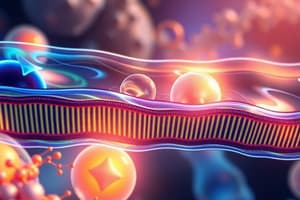Podcast
Questions and Answers
Which component is responsible for maintaining the fluidity of a cell membrane?
Which component is responsible for maintaining the fluidity of a cell membrane?
- Cholesterol (correct)
- Proteins
- Carbohydrates
- Phospholipids
What are the two layers of a cell membrane called?
What are the two layers of a cell membrane called?
Phospholipid bilayer
Cell membranes are impermeable to all substances.
Cell membranes are impermeable to all substances.
False (B)
The fluid mosaic model describes the cell membrane as a __________ of different components.
The fluid mosaic model describes the cell membrane as a __________ of different components.
Match the type of membrane protein with its function:
Match the type of membrane protein with its function:
The phospholipid bilayer is rigid and does not allow movement of its components.
The phospholipid bilayer is rigid and does not allow movement of its components.
What is the primary function of the cell membrane?
What is the primary function of the cell membrane?
Name one function of cholesterol within the cell membrane.
Name one function of cholesterol within the cell membrane.
Cholesterol is not found in the lipid bilayer of cell membranes.
Cholesterol is not found in the lipid bilayer of cell membranes.
What is the primary function of glycoproteins in the cell membrane?
What is the primary function of glycoproteins in the cell membrane?
Name two types of membrane proteins.
Name two types of membrane proteins.
The _____ regulates the fluidity of the cell membrane.
The _____ regulates the fluidity of the cell membrane.
Match the following types of membrane proteins with their functions:
Match the following types of membrane proteins with their functions:
How do receptor proteins assist cells?
How do receptor proteins assist cells?
The carbohydrate chains attached to membrane proteins can be found on the inside surface of the lipid bilayer.
The carbohydrate chains attached to membrane proteins can be found on the inside surface of the lipid bilayer.
Proteins are made up of building blocks called _____ joined by peptide bonds.
Proteins are made up of building blocks called _____ joined by peptide bonds.
What are phospholipids primarily responsible for in the cell membrane?
What are phospholipids primarily responsible for in the cell membrane?
The hydrophilic region of a phospholipid is the 'water-fearing' tail.
The hydrophilic region of a phospholipid is the 'water-fearing' tail.
Which components are responsible for selective permeability in cell membranes?
Which components are responsible for selective permeability in cell membranes?
Carbohydrates are primarily found on the ______ surface of the plasma membrane.
Carbohydrates are primarily found on the ______ surface of the plasma membrane.
Match the terms with their correct descriptions:
Match the terms with their correct descriptions:
What role does cholesterol play in cell membranes?
What role does cholesterol play in cell membranes?
The lipid bilayer structure is impermeable to all substances.
The lipid bilayer structure is impermeable to all substances.
What did the Dutch scientists Gorter and Grendel propose about the nature of the plasma membrane?
What did the Dutch scientists Gorter and Grendel propose about the nature of the plasma membrane?
Study Notes
The Fluid Mosaic Model of the Cell Membrane
- Proposed by S. Jonathan Singer and Garth Nicholson in 1972.
- The membrane is a "mosaic" of different components, including phospholipids, cholesterol, proteins, and carbohydrates.
- The lipid content of the membrane is responsible for its fluidity, preventing solidification at low temperatures.
- The membrane is 5-10 nm thick.
Why is it called the Fluid Mosaic Model?
- Many types of molecules float along the lipids.
- It's called "fluid" because the phospholipid bilayer is viscous and individual phospholipids can move position.
- It's called "mosaic" because the phospholipid bilayer is embedded with proteins, resulting in a mosaic of components.
Functions of the Cell Membrane
- Protection
- Cell Shape
- Compartmentalization
- Cell Recognition
- Cell Function
- Material Transport
Components of the Cell Membrane
- Phospholipids:
- Amphipathic molecules with hydrophilic (water-loving) heads and hydrophobic (water-fearing) tails.
- Form a bilayer structure, essential for the physical properties of biological membranes.
- First proposed in 1925 by Dutch scientists Evert Gorter and Francois Grendel.
- Cholesterol:
- A lipid found alongside phospholipids in the core of the membrane.
- Regulates membrane fluidity as temperature varies.
- Serves as a base attachment for the cytoskeleton and cell wall in some organisms.
- Supports the cell and maintains its shape.
- Proteins:
- Integral proteins: Embedded within the membrane.
- Peripheral proteins: Loosely attached to the membrane's inner or outer face.
- Monitor and maintain the chemical climate of the cell.
- Assist in transferring molecules across the membrane.
- Carbohydrates:
- Only on the outer surface of the lipid bilayer or on peripheral proteins.
- Form glycoproteins when attached to proteins or glycolipids when attached to lipids.
- Serve as cell markers for cell recognition.
Types of Membrane Proteins
- Glycoproteins: Embedded in the membrane, help with cell communication and molecule transport.
- Receptor proteins: Facilitate communication with the external environment through hormones, neurotransmitters, and other signaling molecules.
- Transport proteins: Transport molecules across cell membranes.
- Structural proteins: Provide support and shape to the cell.
Studying That Suits You
Use AI to generate personalized quizzes and flashcards to suit your learning preferences.
Description
Explore the Fluid Mosaic Model of the Cell Membrane, proposed by Singer and Nicholson. This quiz delves into its components, functions, and the reasoning behind its nomenclature as 'fluid' and 'mosaic.' Test your knowledge of the critical roles played by the cell membrane in cellular processes.



